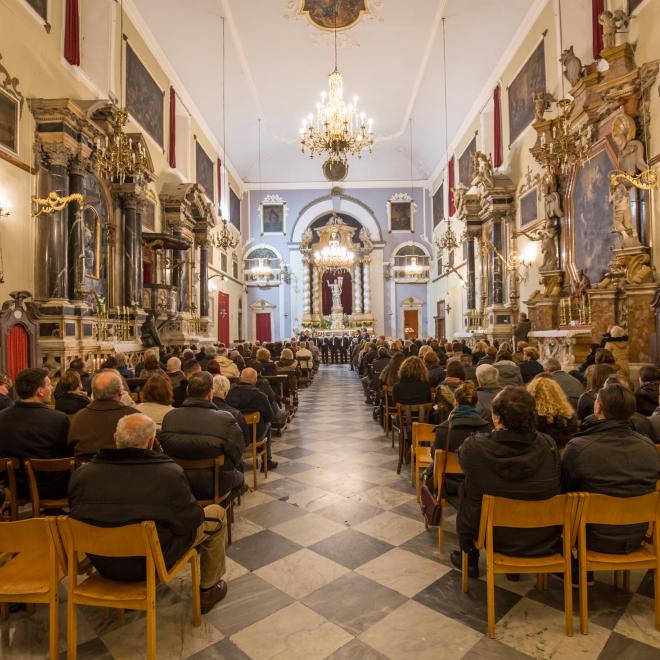
- More
- Performances
- Map
- Archive
Franciscan Church was built in Romanesque - Renaissance style, it has a single nave and is 44m long, 13m wide and 15 high (up to the earthquake which took place on the June 6, 1667 it had 21 altars). The chronicler brother Vital Andrijašević, after the earthquake in 1667, writes that the church: "…on the inside was completely lined with gold and precious paintings; the fire destroyed it. For use in the organ gallery there were seven volumes that were so beautiful that they were beyond compare with anything that was made by the hands of any master craftsman. There were two altars cast from silver and a great altar, which was decorated by two rows of silver statues.There were all in all 26." All was burnt, even the paintings by Tizian, Rafael, Caravaggio along with a magnificent crucifix in a triumphal arch. The very valuable works of the Dubrovnian school (Dobričević and others) unfortunately suffered the same fate. The only remnant of the church is the extremely valuable portal which was the work of the brothers Leonard and Petar Petrović and is situated on the south wall. It is a Pieta (which depicts the Blessed Virgin gently supporting the body of the dead Christ) from 1498. Above the doorposts on may see the figures of St. Jerome to one side and St. John to the other of the lunette. The depiction of God the Father is situated above the lunette. After the earthquake and fire the church was restored in a Renaissance-Baroque style. It is one of the most beautiful churches in Dubrovnik. It has seven stone and one wooden Monumental main altar which was made by Celio of Ancona in 1713 while the sculptor of the statue was Marin Groppelli of Venice. The altar of The Immaculate Conception was built in 1684 by Giuseppe Sardi of Venice. The author of the painting is unknown. The altar of our Lady of Carmel was built in 1696 and was built by Francesco Cabianco. The artist which painted the painting of the altar of St. Cross is unknown but was built in 1689 by Guiseppe Sardi of Venice. The Crucifix by an unknown artist is from the 17th century. The altar of St. Diego by Didaka of Alkal is of wood and was made in the 18th century. The sculptor and painter of the elements of this altar are unknown. The altar of Our Lady of the Sacred Heart of Jesus was built in 1696 by Guiseppe Sardi of Venice. The statue was made by Giovanni Angelini of Bergam in 1875. The painter was Batista Riva also of Bergam in 1875. The altar of St. Anthony of Padova was built in 1790. The builder was also Guiseppe Sardi of Venice. The statue dates back to the 17th century. The sculptor is unknown. The painting is by Ivo Dulčić and dates back to 1962. The altar of St. Francis of Assisi was built in 1689 by Guiseppe Sardi of Venice. The painting dates back to 1889 and is by Celestin Medović. On the walls one can find The Stations of the Cross painted by Josip Romanus of Cremona in 1840. Above them one may see paintings depicting the life of Christ painted by an unknown artist. The relief work on the pulpit dates back to the 15th century. The organ is the work of the brothers Rieger and dates back to 1909. Janez Jenko of Ljubljana restored it to its original state in 1933 . The first organ was from 1690 (the work of a Venetian builder) while the next dates back to 1882 (the work of the Bassani company) The artistically valuable housing for the organ is in the baroque style and depicts the four evangelists. The sacristy did not burn in the fire and is still in the Gothic style. There one may find an altar-relic with a triptych which was painted by Pier Antonio Palmerini in 1528-1529. The intarsia (which is the decorating of wooden artefacts with the inlaying of other woods or materials) above the wardrobe on the northern section are very valuable. They depict the risen Christ with Franciscan saints. In 1963 the sacristy was tiled with polished stone slabs above the graves. The two memorials slates remind us of those who are buried there. Today the church of the Friars Minor is a very popular place for the staging of musical concerts as well as a place of great sacramental importance.
